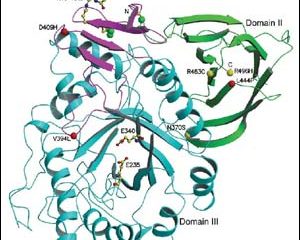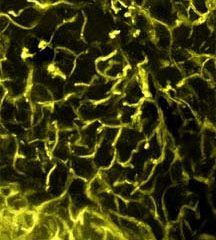Interdisciplinary Research
News and developments from the field of interdisciplinary research.
Among other topics, you can find stimulating reports and articles related to microsystems, emotions research, futures research and stratospheric research.

Virtual reality helps scientists to see how we see
Oxford scientists are using the latest virtual reality technology to study how we perceive the world in 3D. The “immersive virtual reality” used by the Virtual Reality Research Group at Oxford University allows subjects to walk around or look up and down while what they see through a headset changes accordingly – they can explore the virtual environment by literally walking around. Meanwhile, the scientists monitor how they are perceiving the dimensions of their ‘Matrix’-style world.
The res

Weizmann institute scientists solve the 3-D structure of the enzyme involved in Gaucher disease
Discovery may help design effective therapies for the genetic disease that mainly affects Ashkenazi Jews
An interdisciplinary team of Weizmann Institute scientists has solved the three-dimensional structure of an enzyme called glucocerebrosidase. Mutations occurring in this enzyme cause Gaucher disease, a genetic illness that mainly affects Ashkenazi Jews. The Institute study, published recently in EMBO Reports, may lead to the design of effective new therapies for treating the disea

Collaboration at EMSL produces innovative mass spectrometer
The future of proteomics is in good hands with one of the most powerful and versatile mass spectrometers being developed by scientists and engineers from the William R. Wiley Environmental Molecular Sciences Laboratory.
The high-throughput Fourier transform ion cyclotron resonance (FTICR) mass spectrometer and automated liquid chromatography (LC) system is a breakthrough in mass spectrometry capable of improving the understanding of protein production, function and interactions at the cellul

3-D imaging inside living organism, using quantum dots coursing through mouse’s body, reported by Cornell researchers
Tiny blood vessels, viewed beneath a mouse’s skin with a newly developed application of multiphoton microscopy, appear so bright and vivid in high-resolution images that researchers can see the vessel walls ripple with each heartbeat — 640 times a minute.
The capillaries are illuminated in unprecedented detail using fluorescence imaging labels, which are molecule-size nanocrystals called quantum dots circulating through the bloodstream. Quantum dots are microscopic metal or semiconductor

Computational method identifies genes that regulate the cell´s machinery
An interdisciplinary team of researchers from the Hebrew University of Jerusalem, Stanford University and Tel Aviv University has developed the first computational method that can identify clusters of genes responsible for controlling processes within a cell, when those clusters become active, and, most importantly, how the clusters are regulated.
In a paper published online May 12 by Nature Genetics, the researchers report that their method revealed several previously unknown control, or r

Math discovery may aid resource management
With the aid of a chance discovery by a graduate student, scientists from Oregon State University have identified, dusted off and found a new use for an old math theory from the early 1800s that could revolutionize the management of lands, protection of species and study of ecology.
The discovery promises for the first time to address the enormous complexities of the natural world with the powerful tools of advanced mathematics – which, until now, have been of limited use in the study of man